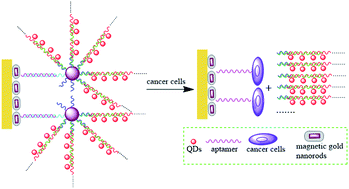Sensitive electrochemiluminescence detection of cancer cells based on a CdSe/ZnS quantum dot nanocluster by multibranched hybridization chain reaction on gold nanoparticles†
Abstract
In this work, we prepared a novel amplified electrochemiluminescence (ECL) signal probe based on a CdSe/ZnS quantum dot (QD) nanocluster by multibranched DNA hybridization chain reaction (HCR) on gold nanoparticles (GNPs), and developed a sensitive ECL biosensor for the detection of cancer cells. Firstly, a new gold nanorod–hematite nanostructure was used as a magnetic nano-amplified platform to assemble abundant capture DNA (aptamer) on the electrode. Next, the probe DNA was hybridized with the aptamers and multibranched HCR was initiated on the GNPs. Thus the numerous QD nanoclusters showed highly intense ECL signal. Finally, the electrodes were incubated in target cancer cells for 50 min. Upon specific recognition of target cells to aptamers, the signal probes were released from the electrode. Thus a small amount of target cells can trigger the release of a large number of QDs, leading to a remarkable amplification of ECL signal, which was used for sensitive detection of cancer cells. The change of ECL signal was linear to the cell concentrations in the range of 500–10 000 cells mL−1, and the detection limit was 230 cells mL−1 at 3σ. A series of five duplicate measurements of 2000 cells mL−1 were used for estimating the precision, and the relative standard was 6.1%. Importantly, the proposed strategy combines the excellent ECL of QDs with cooperative amplification of HCR and the nano-enhanced effect of GNPs, which enables sensitive and selective detection of cancer cells. So far, the QD nanocluster has been used as an ECL signal probe for assays of cancer cells for the first time, and has great potential for early clinical applications in the diagnosis of cancer.


 Please wait while we load your content...
Please wait while we load your content...